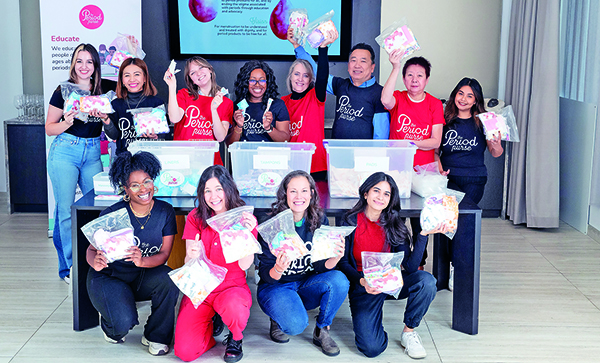General News » News
Landmarks lit red to raise awareness of menstrual health, period poverty
June 5, 2025 · 0 Comments

Fifty-one per cent of the population menstruates, yet it’s a subject people are often reluctant to talk about.
That’s something the Period Purse hoped to change last week as they partnered with municipalities across Ontario, including Aurora, to light up local landmarks in red and send a message that “Every Day is Menstrual Health Day.”
Aurora Town Square was one such landmark to take part and organizers hoped the movement would spark a conversation not just on menstruation, but the stigma surrounding it and efforts to reduce “period poverty” nationwide.
According to the Period Purse, while more than half the population menstruates, just 46 per cent feel comfortable talking about their periods, and one in six experience period poverty – that is an inability to buy or otherwise secure proper hygiene products.
“What’s informing period poverty trends is really diverse, based on population density or population makeup, as well as environmental and climate factors, and then economic resources. In a place like Toronto, period poverty looks very differently than it would in Yellowknife or even in British Columbia, because we all experience life tugs and pulls in different ways,” says Kristy Van Hoven of Period Purse. “In some communities, access to clean water or supplies just by distance can be a bigger challenge than perhaps a place where there’s a high immigrant population and language becomes a barrier to accessing period supplies. The driver for poverty is different, but at the end of the day people are losing out on participating in their communities because they don’t have access to the education or the supplies they need to have a good, healthy period.”
Stigma can also be fostered on many fronts, whether it is cultural or generational. Someone that associates menstruation with shame, for instance, can pass this along to the next generation, says Van Hoven. Other factors can include religious contexts or simply lack of knowledge.
“Stigma definitely exists and there’s a lot of factors playing into it,” she says. “I think our goal to overcome that is looking at our education programs and our outreach to see if we can find a baseline common language that everybody can use to talk about their periods that is comfortable, safe, but also scientifically informed, so at least we’re starting somewhere and we can explore how culture and lived experience plays into that after we have our baseline that we can all communicate equally on.”
As work continues to establish a baseline, the Period Purse is already able to look back on ways they’ve been able to make inroads. Asked to provide measures of success on their mandate, Van Hoven says some of the ways they count it are through menstrual policies being established in schools and workplaces, more access to products at the public level, such as in public washrooms, at information desks at local libraries, malls, and airports.
“The quick demonstration of equity is easily accessible, quality products, and the real barrier there is getting started. At The Period Purse, we’re developing a program and looking for partners who will help us help them navigate how to implement a free period product program in either their workplace or schools. The second thing, we had a research program over the winter where we tried to figure out the attrition rate for work and school for those that are experiencing period poverty and not being able to participate in work or be at school for any length of time because of period needs. There’s not a whole lot of data, but our gut check is if we can institute some policies like in the workplace for menstrual leave or a work from home day instead of a forced in-office day for those experiencing harder or challenging periods, or if there’s a way to do virtual learning for a student that may need to be out because of a period-related situation, then does that actually contribute to the overall wellbeing of the community? The economic impact of losing workers a day or two every month can be huge.”
To this end, The Period Purse has been actively rolling out “school action kits” online that helps kids navigate starting the conversation.
“The first step is really to look at your washrooms. Do you know where the period products are in your school or community spaces that you use? If you go to, like, the hockey rink for practice or soccer field, do you know where the period supplies are and are they accessible? Are you comfy with how you can get a hold of them? If not, then start trying to identify what adults you can talk to or what colleague you can talk to…and you want to take some change. And then start having those conversations: This is what I need to be successful in this space, and what can we do to change that? At some point, it becomes a procurement and distribution kind of conversation and The Period Purse is happy to step in there and make some recommendations about how and where to put dispensers in, how to work with schools or community partners to have some buying power behind keeping supplies stocked… we really encourage them to reach out to us and we can help kind of navigate that implementation phase when they’re ready.
“When school ramps back up, we’re hoping to get into more classrooms and we are offering free period education programs through the end of the year, so anybody that’s interested in bringing one of our educators in to help kids learn about periods or learn about period poverty and what they can do, you can certainly book those sessions through our website.”
For more information about these and other initiatives, visit theperiodpurse.com.
By Brock Weir












